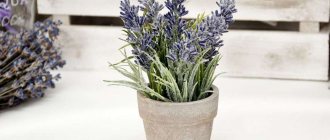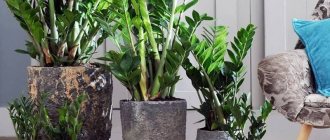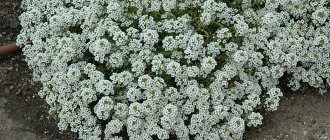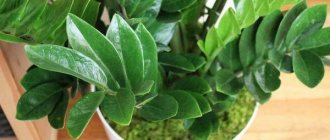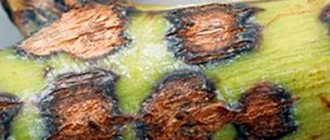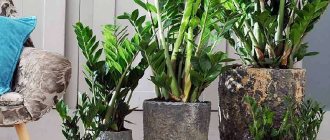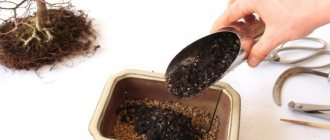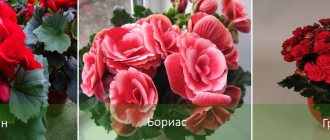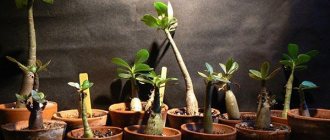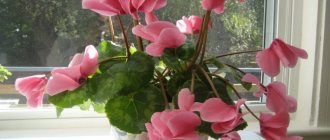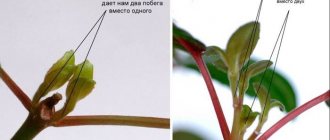Zamioculcas or dollar tree impresses with its exquisite appearance. Thanks to its simple care, exotic is popular among professionals and beginner flower growers. The plant has been decorating window sills for many years, but for successful cultivation it is very important to know how to transplant a dollar tree at home into another pot.
Choosing a Pot for Your Dollar Tree
Zamioculcas prefers tightness rather than spaciousness. That is why, when determining how to transplant zamioculcas into another pot, special attention should be paid to the size of the pot: the optimal container size is 2-4 cm larger than the previous diameter.
A pot that is too large leads to stunted growth of the above-ground part of the crop. The dollar tree actively forms root tubers until they completely master the earthen ball.
Professionals recommend what kind of pot is needed for Zamioculcas:
- The diameter of the container is 2-3 cm larger than the previous one if the tubers are cramped.
- The shape is wide and shallow. The tubers of the plant grow very quickly and can be damaged when planted in deep pots - getting them out of the soil is very difficult.
- Material: plastic or ceramic. The gardener should take into account that when planting in plastic pots, their deformation is very often observed. When planting zamioculcas in clay or ceramic containers, the gardener should monitor their development: too much crowding causes the death of the bush.
Experienced flower growers recommend using a plastic pot for zamioculcas, and how to choose the size of the container. It is from such containers that the plant is easiest to get out of – the pot is simply cut. In addition, the soft walls of the container visually convey the growth of root tubers - this is a direct call for excavation work.
Landing
Reproduction of Zamioculcas is possible in various ways:
- cutting;
- leaf with roots;
- leaf without roots;
- young leaves.
A shoot (cutting)
Cuttings of the stem are carried out in the following sequence:
- the shoot is cut 1 cm above the soil level in the pot;
- in the middle of the spaces between the leaves, the stem is cut into pieces;
- the resulting cuttings are dried for about 1 hour;
- the cuttings are planted in vermiculite and watered well;
- within a month, saturation with nutrients and rooting occurs.
Video: propagation of Zamioculcas by cuttings
Mature leaf
A leaf taken from an adult crop can be rooted and planted to form a new bush:
- pinch off or cut off a strong, healthy leaf;
- plant it in perlite, wet sand or a mixture of these components with peat;
- apply growth and rooting stimulants - “Zircon”, “Kornevin”, etc.;
- Cover the container with film or glass and place in a warm place with light lighting;
- rooting and tuber formation lasts from 1 to 2–3 months.
Video: propagation of Zamioculcas by an adult leaf
Mature leaf without roots
You can try to propagate Zamioculcas by placing an adult leaf in a container of water (a glass, a small glass). This method requires patience, since it may take several months for roots to appear. However, the roots may never appear, which many plant growers complain about.
Leaflets
It is promising to grow with young leaves or even a small twig - young shoots tend to take root and form a tuber. True, this happens extremely slowly - over a year of growth, the tuber will have a diameter of about 2 cm.
Transplant timing
Zamioculcas is characterized by slow growth (if Zamioculcas does not grow, read our article). Young specimens should be replanted annually in the spring. Bushes at the age of 5 years are replanted once every 2-3 years only when the root fills the entire pot. A mature crop is not replanted at all. Once the bush has reached its maximum size, it is left alone. To renew the soil in the pot, replace the top ball.
After purchase, the zamioculcas is placed on a separate windowsill for quarantine. The plant is isolated for 2-3 weeks, allowing it to acclimatize. After this period, the bush is transferred to a suitable pot.
If the dollar tree is purchased from abroad, it is recommended to replant the plant immediately. The importance of quickly completing the procedure lies in the fact that many nurseries fill the soil with “harmful nutrition”, which allows the flowers to look gorgeous. But such soil is very dangerous.
Important ! All work related to transplanting zamioculcas must be carried out carefully and with gloves. Tubers are capable of releasing toxic juice when damaged.
Features of home maintenance
For all its presentable and luxurious appearance, the zamioculcas, or dollar tree, is very easy to care for. It is not without reason that it is called a plant for lazy housewives.
Zamioculcas is very popular in indoor floriculture.
Humidity
Having perfectly adapted to the conditions of our apartments, Zamioculcas easily endures even the heating season. And if the handsome man is completely indifferent to spraying, then wiping the leaves with a damp cloth or infrequent bathing in the shower will be gratefully accepted. Such procedures will free the accumulated dust and help the plant to express itself in all its glory.
Lighting
The plant is also not particularly demanding of lighting; it feels great in bright (but it still needs to be slightly shaded from direct sun) and diffused light. In summer it readily grows in the fresh air. But in winter it is better to place the zamioculcas closer to the window so that during the short photoperiod the plant does not lose the rich color of the leaves.
Zamioculcas likes to spend summer outdoors
Temperature
A native of the hot African continent loves warmth. Therefore, when the thermometer creeps towards +30°C, Zamioculcas feels quite normal. But still, a comfortable temperature in summer should be +20...+25°C. In winter, it is preferable to keep the plant in cooler conditions, at +16...+20°C. The critical temperature in winter is not lower than +12°C.
Watering
Zamioculcas should be watered carefully, because due to the ability to accumulate water in the roots, the plant often suffers from waterlogging of the soil. In the summer, before the next watering, you need to wait until the soil in the pot is half dry. In winter, when kept in a cool room, watering is reduced to a minimum, making the next moistening almost after the substrate has completely dried, which can be determined by the color of the soil - dried soil is a lighter shade.
Feeding
During the growing season, from March to September, zamioculcas is fertilized once every 2 weeks. Feeding must be chosen carefully. Compositions containing nitrogen can harm the root system, as well as a high concentration of solution. For Zamioculcas, it is better to use fertilizers for succulents and cacti, diluting the dose in more water than indicated.
Fertilizer is applied only to moist soil.
Zamioculcas should be fed carefully, in reduced doses.
Transfer rules
Professionals recommend how to properly transplant a dollar tree. By following the simple rules of breeders, you can achieve rapid development of tubers and the above-ground part of the crop.
Transplant secrets from professionals:
- Zamioculcas are handled very carefully without destroying the earth. The slightest damage to the tubers can lead to the death of the flower.
- Before removing the plant from the pot, press the sides of the plastic container with your hands. The procedure will allow you to painlessly separate the roots from the walls.
- Changing the soil under a healthy plant is strictly prohibited.
- The presence of drainage holes in the selected pot is mandatory, since stagnation of water and waterlogging of the soil is death for an exotic guest.
Important ! Tubers are planted in a new place superficially, carefully compacting them in the soil.
Is it possible to cut off the roots of Zamioculcas when replanting, and how to change the soil in the pot? Quite often, this procedure leads to plant diseases, and therefore the soil is separated from the roots only when absolutely necessary: the formation of rot or the acquisition of a flower in an unsuitable substrate. For such a transplant, it is necessary to soak the roots for 2-3 hours in soft water, wash off the soil, remove damage, sprinkle with crushed coal, dry for 2 hours in the shade and replant after laying drainage and filling with special soil.
Botanical description of the plant
This shrub, a member of the Araceae family, is native to Madagascar and Kenya, where it is often found growing wild. In nature, the plant grows to a height of 1 m and lives for 5–10 years. A tuber forms in the soil, retaining moisture and providing vitality during the driest periods. Zamioculcas, which has another common name - the dollar tree, blooms with a cob, typical of many representatives of its family. At home, it is almost impossible to achieve flowering.
Soil and drainage
When determining what kind of soil is needed for zamioculcas, it is recommended to be guided by its natural place of growth. The dollar tree prefers light, loose soil. It is the air permeability of the soil that promotes the active development of root tubers.
What is the best soil for Zamioculcas? The answer is - this is a ready-made soil mixture for succulents or a substrate prepared independently.
Soil for dollar tree:
- 1 part sand.
- 1 part peat.
- 0.5 parts of turf soil.
- 0.5 parts leaf soil.
- 0.5 parts of humus.
- A handful of perlite.
Zamioculcas reacts painfully to stagnation of water at the roots. Rot affects the tubers almost instantly. That is why, to create favorable conditions for development, laying drainage at the bottom of the container is mandatory.
The drainage layer should be at least ¼ of the pot.
Plant care
This indoor succulent does not require any careful supervision. It is enough to learn only the basic responsibilities of caring for it.
Important! Once every 1
–
For 1.5 months you need to spray the foliage with a solution of urea or complex additives in a small concentration.
Watering Zamioculcas
Since the plant is capable of accumulating moisture underground, it should be watered moderately. The earthen ball is constantly checked for the depth of the wet layer. In this case, there is an unspoken rule: if you have doubts about the need for watering, then postpone it to the next day.
It is worth watching the bush especially carefully in winter, when it is better not to water than to overwater. If overwatered, the foliage may turn yellow and the roots may rot. Watering is done with settled water at room temperature (or a little warmer).
We recommend that you learn about the basic rules for watering zamioculcas at home.
Fertilizer and feeding
Fertilization is usually carried out during the period of leaf formation; at this time the bush responds especially well to feeding. Nutrient mixtures need to be added once every two weeks. In this case, organic and mineral fertilizers alternate. Both complexes for indoor plants and specialized fertilizers for cacti and succulents are used. When using fertilizers for indoor crops, they are diluted to a concentration of 50%.
Reproduction and transplantation
How to properly grow a new bush was discussed above. But there is a way by which you can immediately obtain an adult culture. We are talking about dividing the tuber.
The reproduction technology is as follows:
- during transplantation, the tuber is carefully divided into several parts, each of which should contain shoots;
- parts need to be planted in prepared pots in the soil, as for an adult bush;
- the first week the so-called “divisions” are not watered;
- then they resume full care of the adult zamioculcas.
Transshipment
Healthy zamioculcas is transplanted using the transshipment method. Fragile roots require careful behavior by the grower. The planned excavation work is carried out in March or early April.
In the new container, the tubers of the bush are placed superficially, buried only 2/3. If you hide the roots underground, preventing the development of rot will be very difficult.
It is not recommended to delay replanting the bush, because overgrown tubers are very difficult to remove from the container.
First meeting
This flower appeared in our markets quite recently, so it can not always be found in flower shops.
But if you are lucky, then this plant is perfect for your apartment and office. This unpretentious flower fits very well into the decor of any home.
When you bring it home, you will notice that it tolerates dry air and low light very well, which is especially important in winter. The plant grows quite slowly.
In addition, it is a symbol of prosperity; it is also called the dollar tree. This may be due to its similarity to the money tree.
Dollar Tree in all its glory
According to the rules of Feng Shui, when you bring a flower home, it must be placed in the wealth zone. A correctly selected zone will help enhance the properties of this talisman.
There are also a large number of legends about this plant, according to which it can both bring misfortune to the house (that’s why it is called the flower of celibacy) and make its owner happy.
Possible problems
Despite the fact that caring for exotic Zamioculcas is quite simple, a number of problems may arise during cultivation. Some of them are caused by incorrectly performed transplantation.
| Problem | Cause | Solution |
| Loss of foliage | Excessive moisture/prolonged drought. | Systematize the irrigation system |
| High content of peat or clay in the substrate. | Transplanting into the most suitable soil mixture | |
| Suspension of development | The plant grows in a pot that is too large, and therefore uses reserves for the roots to absorb the contents of the container | Transplanted into containers recommended in size |
| The leaves turned yellow and became flabby | Root system rotting. It is also worth considering that in adult plants the leaves turn yellow and dry out during natural processes | Reduce the number of waterings. If it was not possible to solve the problem in this way, replant it in new soil and change the substrate to a drier one. In the future, make sure that moisture does not stagnate in the pan. If necessary, the affected segments are cut off, the sections are disinfected with crushed activated carbon. |
Diseases and pests
Zamioculcas is rarely susceptible to diseases; most often, its damage can be caused by a lack of moisture, temperature changes, and drafts.
Among the pests that attack the plant, the most common are: spider mites, scale insects, aphids:
- Spider mites are small insects that settle on leaves and cover them with white webs. You can cope with spider mites by spraying and washing the leaves. This is done using a weak tobacco infusion, or treated with special solutions.
- Scale insects are quite a dangerous pest; they multiply quickly and cover the leaves of the plant with dark spots. The pest is destroyed by spraying the flower with a soap solution with the addition of a small amount of kerosene.
- Very often, aphids . It affects the lower part of the leaf and causes the leaf to curl and dry out. To kill aphids, drugs are used that can be purchased at flower shops. After the procedure, wash the flower well, while covering the soil. If necessary, treatment with drugs is repeated.
Remember that the healthy appearance of a flower largely depends on care, and in order for Zamioculcas to become a pet and feel good, it needs not only proper care, but also your love.
Varieties and features
The genus of this plant is represented by the only species, Zamioculcas zamiaefolia.
But today there are several varieties of it, which are not separate species.
In 1929, the scientist Gustav Albert Peter first outlined the description of Zamioculcas lanceolate. This species is often found in Mozambique and is distinguished by its elongated leaf shape.
Another species grows in East Africa, this is Zamioculcas Boivin. However, today this plant is classified as a different genus of araceae.
Today, you can often find only one species of this plant on sale. But, since the plant is just gaining its popularity, breeding work is underway to develop new varieties and species.
Already in 2007, the first cultivar of this flower, the Zamicro variety, appeared on the market. It grows about 60 cm, is distinguished by its smaller leaves and its unpretentiousness.
In the photo, Zamioculcas zamiaefolia
